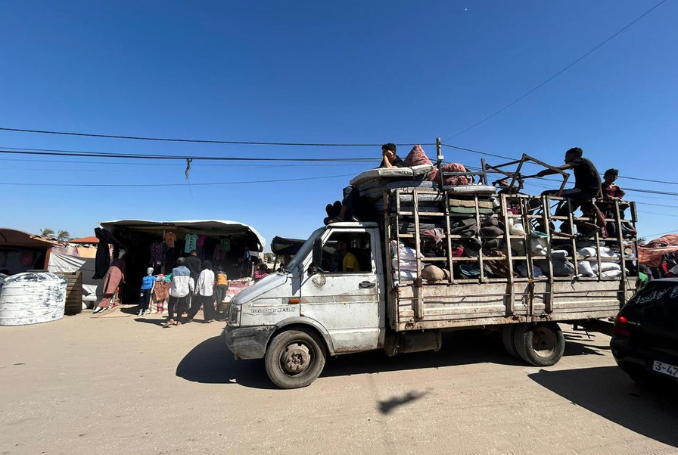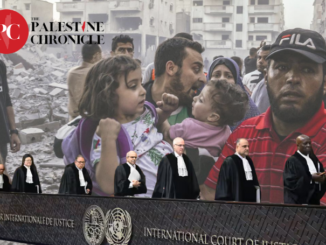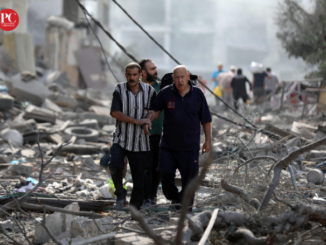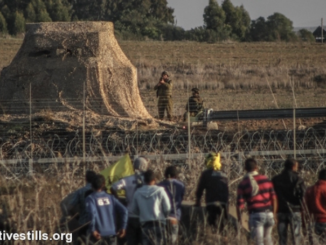
Today’s evacuation orders come a few days after the United Nations (UN) announced that 84 percent of the population in Gaza is under evacuation orders by the Israeli army.
The Israeli army issued new evacuation orders on Friday to Palestinians in various areas previously classified as “humanitarian safe zones” in central and southern Gaza.
The evacuation warnings came in the form of text messages sent to residents and displaced Palestinians alike along with flyers dropped in the northern area of Khan Yunis, in the southern Gaza Strip, and in neighborhoods in the eastern part of Deir al-Balah, in central Gaza, according to Reuters news agency.
The Israeli army claimed that these areas were used by Hamas “as a base for firing mortars and rockets towards Israel,” Reuters said.
Israel has repeatedly claimed that Hamas uses civilian infrastructure and population as command centers for its operations.
? Heavy bombing now targets residential towers in Hamad town west of Khan Younis in the southern #Gaza Strip after forced evacuations this morning.
Meanwhile, armed clashes continue east of Al-Bureij and Deir Al-Balah in the central #Gaza Strip pic.twitter.com/stzTEwtnPQ
— Julie Webb-Pullman (@juliewebbp) August 16, 2024
The Palestinian group, however, has always denied operating from civilian facilities.
In 2014, following a deadly Israeli war on the Strip, Amnesty International investigated Israeli claims and reported that no evidence was found that the Palestinian group intentionally used civilians as shields.
Systematic Policy
Today’s evacuation orders come a few days after the United Nations (UN) announced that 84 percent of the population in Gaza is under evacuation orders by the Israeli army.
The United Nations’s Office for the Coordination of Humanitarian Affairs (OCHA) has warned last month against the repeated Israeli evacuation orders saying they “will only fuel mass suffering for Palestinian families.”
WHO: The World Health Organization announced that the urgently needed medical evacuations from the Gaza Strip, which were originally limited, have completely stopped after the Israeli attack on Rafah about 3 weeks ago.
FOLLOW OUR LIVE BLOG https://t.co/hwgsvEw1nB pic.twitter.com/8HUwGPHdIY
— The Palestine Chronicle (@PalestineChron) May 29, 2024
The UN organization requested all parties to respect international humanitarian law at all times. “These civilians must be protected – and their essential needs must be met, whether they flee or stay,” OCHA said.
For its part, Amnesty International has labeled the repeated evacuation orders as amounting to “unlawful transfer, a war crime.”
Ongoing Genocide
Flouting a UN Security Council resolution demanding an immediate ceasefire, Israel has faced international condemnation amid its continued brutal offensive on Gaza.
Currently on trial before the International Court of Justice for genocide against Palestinians, Israel has been waging a devastating war on Gaza since October 7.
According to Gaza’s Ministry of Health, 40,005 Palestinians have been killed, and 92,401 wounded in Israel’s ongoing genocide in Gaza starting on October 7.
Moreover, at least 11,000 people are unaccounted for, presumed dead under the rubble of their homes throughout the Strip.
Israel says that 1,200 soldiers and civilians were killed during the Al-Aqsa Flood Operation on October 7. Israeli media published reports suggesting that many Israelis were killed on that day by ‘friendly fire’.
Palestinian and international organizations say that the majority of those killed and wounded are women and children.
The Israeli war has resulted in an acute famine, mostly in northern Gaza, resulting in the death of many Palestinians, mostly children.
The Israeli aggression has also resulted in the forceful displacement of nearly two million people from all over the Gaza Strip, with the vast majority of the displaced forced into the densely crowded southern city of Rafah near the border with Egypt – in what has become Palestine’s largest mass exodus since the 1948 Nakba.
Later in the war, hundreds of thousands of Palestinians began moving from the south to central Gaza in a constant search for safety.
(PC, Anadolu)








